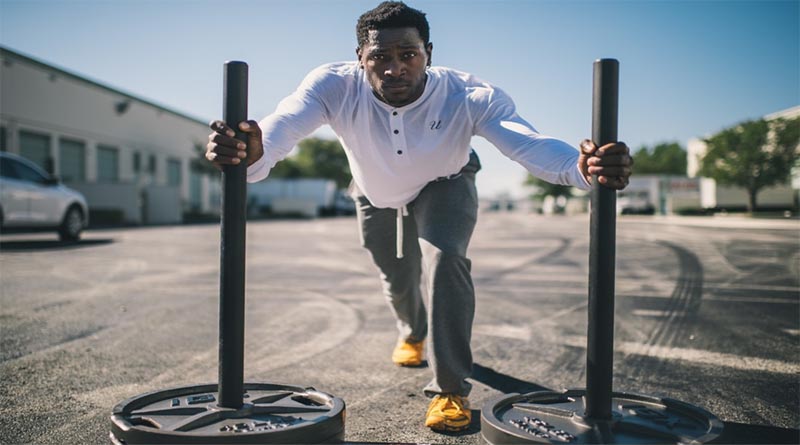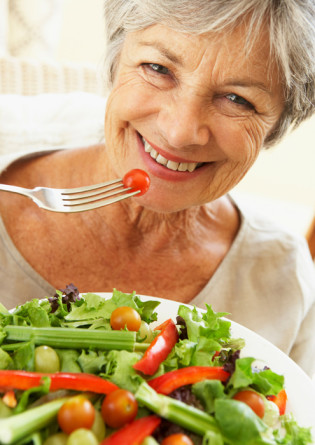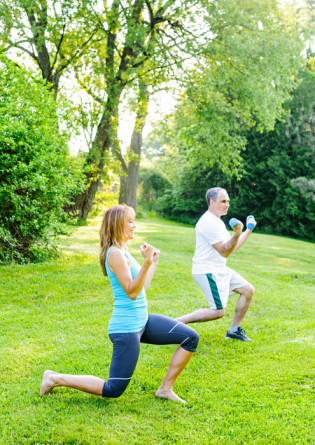USING DIET AND EXERCISE TO DELAY THE AGEING PROCESS
Exercise and proper nutrition may not be a panacea to stop the ageing process – but they can help slow it down. And they can certainly delay the effects of ageing; enabling your clients to enjoy life more and for longer.
There are four specific areas where diet and exercise can help:
- Combat the loss of lean muscle mass
- Mitigate the increased difficulty to lose weight
- Delay the loss of bone strength
- Increase client confidence and self-esteem
- Combat the loss of lean muscle mass
Starting in our 30s, we stand to lose an average of 5% of muscle mass every decade[i]. This loss can be attributed to a several factors, including decreased insulin sensitivity, decreased Human Growth Hormone (HGH) Production or in extreme cases Sarcopenia (the natural deterioration of muscle that is equivalent to osteoporosis in bone).
In all of these examples, vigorous exercise (i.e. full-body movements that recruit numerous muscle groups and challenge the cardio-vascular system like swimming and weight training) can help treat and prevent these symptoms of ageing[ii].
Exercise using full-body movements can deliver positive benefits:
- Increased insulin sensitivity: insulin sensitivity is how your body responds to glucose in your blood stream, and low insulin sensitivity means a greater risk of heart disease, heart failure, obesity, osteoporosis and even cancer[iii].
Regular, vigorous exercise requires energy from glycogen (glucose stored at the cellular level) and blood glucose, meaning that your body will more effectively process glucose as an energy source. This means that you will require less insulin to process blood sugar because you are utilising it to fuel exercise, thereby increasing your insulin sensitivity.
- Reduced muscle deterioration: as you get older, there is a tendency to start moving less. You lose energy, you become lethargic, and you become more inclined to sit and relax as opposed to keeping active.
It may be a cliché but it applies here: ‘move it or lose it’. As you get older if you do not stay active your muscles will deteriorate in part due to decreased hormone production, but also due to inactivity. By keeping your activity levels up through vigorous exercise that uses multiple joints through full ranges of motion, you will strengthen your skeletal muscle that supports your body, keep your posture in alignment, and enables you to maintain independence and move more effectively as you get older.
- Increased energy: vigorous exercise also challenges your cardio vascular system, improving stamina and giving you a renewed level of energy.
The heart is a muscle like any other, and with focused effort it will get stronger. Because vigorous exercises recruits more muscle groups the heart must work harder to address the increased demand. Through intense training protocols like High Intensity Interval Training and Tabata Intervals, the heart will be challenged to the point where it adapts to meet the increased demand. When this adaptation takes place, increased stamina and vigour are the result. Just be mindful not to over do it and progress slowly up to these types of intense activities.
Advice: exercise is an activity that will aid in movement that will practically make life easier.

- Mitigate the increased difficulty to lose weight
Decreased hormone production as we age also makes it more difficult to shed pounds once we put them on.
- Increased Human Growth Hormone (HGH) Production: HGH stimulates bone and hair growth and regulates body composition in children and adolescents, and begins to decline from the age of 30 and more steadily thereafter[iv].
Increasing vigorous exercise boosts natural production of HGH, thereby stimulating the body’s continued ability to regulate and regenerate itself by regulating body composition and stimulating bone growth. This means that by exercising we become more capable of controlling weight gain as well as preventing conditions such as osteoporosis.
- Increased metabolic activity through increased lean muscle mass: one of the disadvantages of dieting only in the pursuit of weight loss is the inadvertent loss of muscle mass while pursuing a smaller number on the scale. This is because dieting can often require giving up essential nutrients (i.e. calorie-rich foods like fats) for the sake of cutting calories.
 Vigorous exercise increases lean muscle mass, which increases overall metabolism. The higher your metabolism, the more calories you require to feed the muscle you have built, and the more calories you will burn after you finish exercising (as long as you continue to vigorously exercise). While your weight may not decrease, by building lean muscle mass you will build a fat-burning furnace, which will consume calories and efficiently metabolise fat both inside and outside the gym.
Vigorous exercise increases lean muscle mass, which increases overall metabolism. The higher your metabolism, the more calories you require to feed the muscle you have built, and the more calories you will burn after you finish exercising (as long as you continue to vigorously exercise). While your weight may not decrease, by building lean muscle mass you will build a fat-burning furnace, which will consume calories and efficiently metabolise fat both inside and outside the gym.
Advice: follow an overall weight-loss plan that includes exercise and healthy eating, as opposed to calorie counting on its own.

- Delay the loss of bone strength
An additional challenge as we age is the loss of bone strength, or osteoporosis. One of the causes of osteoporosis in both men and women is low levels of testosterone and oestrogen respectively[v]. These hormonal levels drop from the age of 30 for men, and from the age of 40 for women.
While exercise increases the natural production of HGH, exercise can also improve bone strength. By concentrating on exercises that use multiple joints (i.e. squats, assisted pull ups, deadlifts), the bone will be challenged along their length, increasing bone strength as well as creating a stronger muscular support system.
This additional muscle strength will improve balance and joint integrity, creating a stronger foundation for both stability and effective movement.
Advice: exercise is an effective way to prevent and avoid falls and joint instability.
- Increase Confidence and Self Esteem
Over and above the physical benefits of exercise on the body, there is additionally the positive change in mind set associated with regular exercise.
The one common trait across all age groups that results from regular exercise is the feeling of personal confidence and renewed purpose. Having worked with ageing clients who seemed frail and fragile during their initial assessment, through regular exercise they have transformed from a picture of fragility to a tower of strength and confidence.
Physical benefits are well documented, but the positive change in mind set resulting from regular physical activity can have equally important and equally long lasting benefits to the client.
Advice: if you need inspiration chat to a contemporary who is currently exercising. The benefits will be readily and immediately apparent.

About the author:
James Staring is a certified fitness professional with experience training endurance runners, triathletes, low back pain sufferers, and weekend warriors of all ability levels.
James focusses on building the best version of you and inspiring you to new levels of fitness – regardless of your current ability or age. In particular James specialises in exercise after injury and helping those who are, perhaps, feeling a little less mobile than they used to.
Web: www.fittolast.co.uk
Twitter: @fittolast
Facebook: www.facebook.com/fittolast
Linkedin (James Staring): uk.linkedin.com/in/fittolast
[i] http://www.sharecare.com/health/types-of-exercise-programs/muscle-mass-after-35
[ii] http://www.berkeleywellness.com/fitness/active-lifestyle/article/slowing-down-muscle-loss
[iii] http://www.diabetes.co.uk/insulin/insulin-sensitivity.html
[iv] http://health.howstuffworks.com/wellness/aging/anti-aging-tips/hgh-aging.htm
[v] http://www.niams.nih.gov/health_info/bone/osteoporosis/osteoporosis_ff.asp

